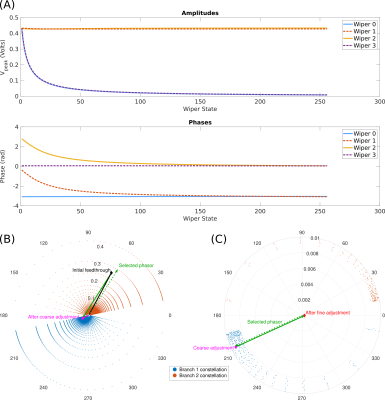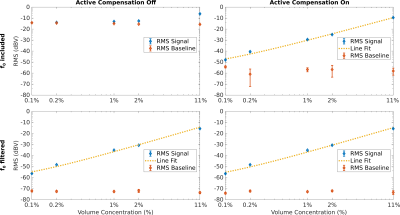4266
Vector Modulator Based Automated Active Compensation of Direct Feedthrough in Magnetic Particle Imaging1Department of Electrical and Electronics Engineering, Bilkent University, Ankara, Turkey, 2National Magnetic Resonance Research Center (UMRAM), Ankara, Turkey
Synopsis
In magnetic particle imaging (MPI), simultaneous excitation and signal acquisition leads to direct feedthrough interference. While this interference can be mitigated up to some extent with passive compensation, its time-varying nature necessitates active compensation methods to achieve the sensitivity levels needed for applications such as stem cell tracking. We have recently proposed an active compensation technique for MRI, which uses a vector modulator and a lookup-table-based algorithm for reducing the direct feedthrough in the analog domain. Here, we adapt this technique to MPI, demonstrating a successful recovery of the fundamental frequency and a significant increase in detection sensitivity.
Introduction
Magnetic Particle Imaging (MPI) is a rapidly developing modality that images the spatial distribution of magnetic nanoparticles (MNPs) by exploiting their nonlinear magnetization1,2. MPI has excellent potential for angiography3, stem cell imaging4, viscosity mapping5,6, and functional imaging7. As MNPs instantaneously align with the applied drive field (DF), the excitation and acquisition are inherently simultaneous. The resulting direct feedthrough contaminates the received signal, saturates the preamplifier, and reduces the dynamic range, jeopardizing MPI’s promise of high sensitivity8. While gradiometer receive coils are frequently used to passively reduce direct feedthrough, their tuning is prone to degradation due to vibration and heating. Even after passive cancellation, the residual feedthrough can easily exceed the signal from a low concentration of MNPs. Therefore, eliminating the direct feedthrough via active compensation (AC) is an active research area in MPI9,10, as it is in other fields such as telecommunications (full-duplex radio)11 and MRI12-18.We have recently proposed an AC method in MRI using a vector modulator13,14 and adapted a similar hardware for MPI, demonstrating preliminary results19. In this work, we incorporate a digitally controlled vector modulator to the MPI system, fully automating the AC process. We propose a look-up table-based algorithm that dynamically compensates for the time-varying direct feedthrough and successfully recovers the fundamental frequency component of the MPI signal. This system achieves more than 40 dB of additional feedthrough suppression in less than two seconds.
Methods
For a DF with a center frequency $$$f_0$$$ and envelope $$$A(t)$$$, the direct feedthrough signal can be formulated as $$$s(t) = k\cdot A(t)\cdot \sin(2 \pi f_0 t+\phi)$$$, where $$$k$$$ and $$$\phi$$$ are the attenuation coefficient and phase shift stemming from mutual coupling, respectively. In this work, the parameters $$$k$$$ and $$$\phi$$$, which are assumed to not change during an acquisition, are estimated and a copy of the direct feedthrough is created to remove it in the analog domain.Active Compensation Circuit
A circuit that can modify the phase and amplitude of its input was designed, as shown in Fig. 1. The circuit contained two branches, where each branch employed a phase shifter that approximately covered a complex half-plane, in terms of relative phase between the input and output. These branches were then weighted summed, and the result was subtracted from the received signal. Both weighted summer and phase shifters were implemented via Op-Amps and were controlled digitally via 8-bit rheostats (MCP4352, Microchip).
Algorithm
As shown in Fig. 2, we developed a lookup-table-based algorithm that alleviates the necessity of searching the input space to generate the desired $$$k$$$ and $$$\phi$$$. To demonstrate the consistency of its performance, the algorithm was applied on 5000 random feedthrough values. The suppression performance was evaluated with/without adding realistic Gaussian noise of 0 mean, 10-4 standard deviation.
Experiment Setup
The proposed technique was demonstrated on an in-house Arbitrary Waveform Relaxometer (AWR), featuring a DF coil with a small (23.4 µH) inductance20. The gradiometer receiver coil had a manual adjustment knob to decrease the feedthrough. The input of the vector modulator was sensed from the transmit coil via a small pickup coil. The output of the modulator was subtracted from the received signal using the differential input of the LNA.
The ability to reduce the direct feedthrough dynamically was demonstrated by heating the coil. The proposed algorithm was kicked off when the feedthrough exceeded a certain threshold.
To demonstrate the recovery of $$$f_0$$$, five samples of Perimag (Micromod GmbH, Germany, c(Fe) = 17mg/mL) with up to 1000-fold dilution were prepared with a 100 µL total volume. DF at 10 mT and $$$f_0$$$ = 10 kHz was applied. The RMS of the acquired signal with/without $$$f_0$$$ were investigated with/without AC.
Results & Discussion
The results of the dynamic cancellation experiment are given in Fig. 3A, where more than 40 dB additional isolation was sustained. Increasing the initial feedthrough did not cripple the performance.The results for MNP dilution series are shown in Fig. 4, where the fundamental frequency of MNPs was recovered without distorting the higher harmonics.
The algorithm runtime was 1.3 secs, which was bottlenecked by four acquisitions that were used to estimate the leak, scalar system gain, coarse and fine compensation results. The runtime could be made faster by reducing the overhead associated with these acquisitions. This approach will make the system more adaptive and increase the additional isolation since the constant feedthrough assumption during the acquisition will be more accurate.
Lower DF amplitudes cause the higher harmonics of the signal to diminish faster. In such cases, recovering $$$f_0$$$ is especially important for improving the detection sensitivity. This feature can be exploited to build low-power, low-cost MPI systems. Finally, the recovery of $$$f_0$$$ can alleviate the necessity of recovering the DC component of the MPI image during reconstruction, eliminating the associated image artifacts.
Conclusions
An active compensation method utilizing a digitally controlled vector modulator and a lookup-table-based cancellation algorithm is proposed to solve the time-varying direct feedthrough problem in MPI. This method can reduce the feedthrough by more than 40 dB in less than two seconds, recover the fundamental frequency of the MPI signal, and enable a significant improvement in sensitivity.Acknowledgements
The authors would like to thank Ecrin Yagiz and Rahmetullah Cagil for their contributions to the initial version of the experimental setup.References
1. Gleich B, Weizenecker J. Tomographic imaging using the nonlinear response of magnetic particles. Nature. 2005;435(7046):1214-1217. doi:10.1038/nature03808
2. Saritas EU, Goodwill PW, Croft LR, et al. Magnetic Particle Imaging (MPI) for NMR and MRI Researchers. J Magn Reson. 2013;229:116-126. doi:10.1016/j.jmr.2012.11.029
3. Rahmer J, Wirtz D, Bontus C, Borgert J, Gleich B. Interactive Magnetic Catheter Steering With 3-D Real-Time Feedback Using Multi-Color Magnetic Particle Imaging. IEEE Trans Med Imaging. 2017;36(7):1449-1456. doi:10.1109/TMI.2017.2679099
4. Zheng B, von See MP, Yu E, et al. Quantitative Magnetic Particle Imaging Monitors the Transplantation, Biodistribution, and Clearance of Stem Cells In Vivo. Theranostics. 2016;6(3):291-301. doi:10.7150/thno.13728
5. Stehning C, Gleich B, Rahmer J. Simultaneous magnetic particle imaging (MPI) and temperature mapping using multi-color MPI. International Journal on Magnetic Particle Imaging. 2016;2(2). Accessed July 5, 2020. https://journal.iwmpi.org/index.php/iwmpi/article/view/34
6. Utkur M, Muslu Y, Saritas EU. Relaxation-based viscosity mapping for magnetic particle imaging. Phys Med Biol. 2017;62(9):3422–3439. doi:10.1088/1361-6560/62/9/3422
7. Mason EE, Cooley CZ, Cauley SF, Griswold MA, Conolly SM, Wald LL. Design analysis of an MPI human functional brain scanner. Int J Magn Part Imaging. 2017;3(1). doi:10.18416/ijmpi.2017.1703008
8. Goodwill PW, Conolly SM. The X-Space Formulation of the Magnetic Particle Imaging Process: 1-D Signal, Resolution, Bandwidth, SNR, SAR, and Magnetostimulation. IEEE Transactions on Medical Imaging. 2010;29(11):1851-1859. doi:10.1109/TMI.2010.2052284
9. Zheng B, Yang W, Massey T, Goodwill PW, Conolly SM. High-power active interference suppression in magnetic particle imaging. In: 2013 International Workshop on Magnetic Particle Imaging (IWMPI). ; 2013:1-1. doi:10.1109/IWMPI.2013.6528381
10. Pantke D, Holle N, Mogarkar A, Straub M, Schulz V. Multifrequency magnetic particle imaging enabled by a combined passive and active drive field feed-through compensation approach. Medical Physics. 2019;46(9):4077-4086. doi:10.1002/mp.13650
11. Bharadia D, McMilin E, Katti S. Full duplex radios. In: ACM SIGCOMM Computer Communication Review. Vol 43. ACM; 2013:375–386.
12. Idiyatullin D, Suddarth S, Corum CA, Adriany G, Garwood M. Continuous SWIFT. Journal of Magnetic Resonance. 2012;220:26-31. doi:10.1016/j.jmr.2012.04.01617.
13. Tasdelen B, Sadeghi-Tarakameh A, Yilmaz U, Atalar E. Dynamic Decoupling for Simultaneous Transmission and Acquisition in MRI. In: Proc. Intl. Soc. Mag. Reson. Med. 27. ; 2019. https://cds.ismrm.org/protected/19MPresentations/abstracts/4503.html
14. Tasdelen B, Sadeghi-Tarakameh A, Yilmaz U, Atalar E. Noise Analysis for Simultaneous Transmission and Reception Enabled MRI Scanner. In: Proc. Intl. Soc. Mag. Reson. Med. 28. ; 2020. https://ww5.aievolution.com/ism2001/index.cfm?do=abs.viewAbs&abs=10383
15. Özen AC, Bock M, Atalar E. Active decoupling of RF coils using a transmit array system. Magnetic Resonance Materials in Physics, Biology and Medicine. 2015;28(6):565-576. doi:10.1007/s10334-015-0497-0
16. Özen AC, Atalar E, Korvink JG, Bock M. In vivo MRI with Concurrent Excitation and Acquisition using Automated Active Analog Cancellation. Scientific Reports. 2018;8(1). doi:10.1038/s41598-018-28894-w
17. Sohn S-M, Vaughan JT, Lagore RL, Garwood M, Idiyatullin D. In vivo MR imaging with simultaneous RF transmission and reception. Magn Reson Med. 2016;76(6):1932-1938. doi:10.1002/mrm.26464
18. Salim M, Ozen AC, Bock M, Atalar E. Active Decoupling of Transmit and Receive Coils for Full-Duplex MRI. arXiv:181010973 [physics]. Published online October 21, 2018. Accessed April 21, 2020. http://arxiv.org/abs/1810.10973
19. Tasdelen B, Yagiz E, Utkur M, et al. Vector Modulator Based Active Compensation of Direct Feedthrough. International Journal on Magnetic Particle Imaging. 2020;6(2 Suppl 1). doi:10.18416/IJMPI.2020.2009065
20. Top CB. An arbitrary waveform magnetic nanoparticle relaxometer with an asymmetrical three-section gradiometric receive coil. Turk J Elec Eng & Comp Sci. 2019;In Press. doi:10.3906/elk-1907-201
Figures



